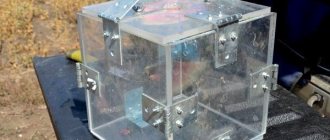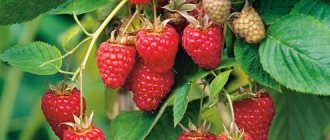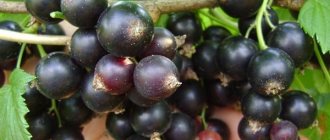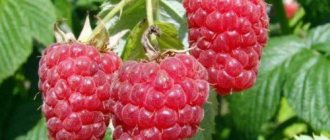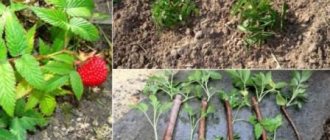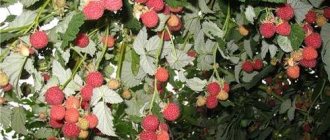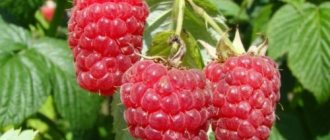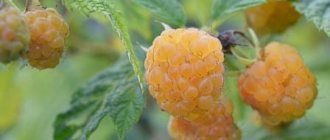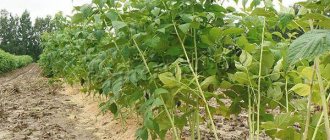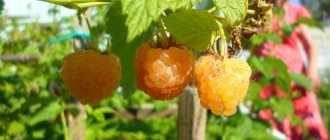The Cumberland black raspberry remains a rare plant in our country to this day. The bush looks very unusual; many people confuse it with blackberries. In addition to beauty, the berry is valued for its taste and healing qualities. Despite its low prevalence in Russia, Cumberland raspberries are winning the hearts of gardeners, thanks to their unpretentiousness to living conditions, and deserve a place of honor in every garden.
Raspberry Cumberland
Cumberland raspberries have a sweet and sour taste
The height of the raspberry bush is about 2.5 m
The history of the creation of the variety and its appearance in our gardens
Cumberland raspberries resemble blackberries in appearance. Its homeland is North America, where this variety is not considered exotic; American residents have been growing the bush for many years.
The time of creation is 1888; the plant was brought to Russia 90 years later. But, despite the relatively long stay of the variety on our territory, summer residents are in no hurry to grow it on an industrial scale.
Reviews from gardeners claim that this is due to their love for their bred raspberry varieties, and Cumberland is considered a foreign plant that deserves a separate place in the garden, but nothing more.
Description of the plant
The Cumberland bush is a real decoration of the garden. The plant is powerful, up to 2.5 m high, but not spreading. The shoots first grow straight and then begin to bend, forming an arch. The stems are thick (up to 3 cm in diameter), with short internodes, and studded with numerous sharp thorns. Young shoots are green in color with a waxy coating of a bluish or purple hue. The two-year stem is brown.
Video: Cumberland black raspberries in my garden
Due to its good growth, Cumberland is often used as a hedge.
The leaf blade is complex. The surface is wrinkled, slightly rough, bright green in color. The underside of the leaf is grayish, with slight pubescence. There are spines, but they are small and in their infancy.
The flowers are small and white. Collected in racemose inflorescences of 10 - 15 pieces. They are located mainly on the tips of shoots or in the axils of leaves.
The berries are round in shape and small in size - their average weight is 2 g. At the moment when the berry is just poured, its usual color is scarlet. But a ripe berry looks unusual. Its color can range from dark purple to black. The skin is dense and shiny, with a bluish coating between the drupes.
Cumberland berries have a very unusual color and look more like blackberries than raspberries.
You can tell Cumberland raspberries from blackberries at the time of picking. Ripe raspberries are separated from the stalk very easily. And the blackberries are torn off only with the tail.
Cumberland berries have a rather bright dessert taste, in which sweetness predominates, the sourness is slightly noticeable. The drupes are medium juicy, with a blackberry flavor and a pleasant aroma. The only drawback is that they contain a lot of seeds. Taste qualities are rated from 3.8 to 5 points.
Video: Cumberland raspberries - first impressions
What characteristics do Cumberland raspberries have?
Black Cumberland raspberries are the highlight of any garden; they are often grown not to produce a large amount of harvest, but to decorate the site. The bush is very strong, hardy and tall. It brings a lot of berries, they are all small in size, but have excellent taste.
The main external characteristics of the variety:
- height about 2.5 m, and sometimes 3 m;
- not a spreading bush, young shoots grow straight upward, but with age they bend, forming an arch;
- stem thickness 3 cm, the distance between internodes on the stem is minimal, the stem has thorns;
- shoots at an early age are bright green, the purple film that covers them is slightly visible, with age the branches become brown;
- leaves are complex, large, 5 leaf blades are collected on one branch, jagged on the sides, smooth to the touch;
- the root system is fibrous, although it has several rod processes that help to work out the process of fruiting during drought;
- one berry weighs about 2 g, is small in size, in an unripe state the young berry is light pink in color, gradually it turns red and then turns black;
- the fruits have a sweet taste with a slight sourness, they contain a large number of seeds;
- According to the taste characteristics, the berries deserve a rating of 4 to 5 points.
It is very easy to distinguish Cumberland raspberries from blackberries - during harvesting, the fruits of raspberries easily come off the stem, but blackberries have problems with this. Blackberries can only be harvested with their stems.
Characteristics of the variety
If you want to grow an unusual crop in the garden, you should take a closer look at the description of the Cumberland black raspberry, find out all its whims, positive and negative traits.
Drought resistance, frost resistance
If we compare the Cumberland variety with red raspberries, then the aronia crop is inferior in winter hardiness. The plant can survive temperatures as low as –24°C. However, there are reviews where gardeners claim that with good shelter, Cumberland bushes can withstand down to –30°C. But black raspberries can boast of drought resistance, but this feature cannot be speculated on. With a lack of moisture, the quality of the berries deteriorates.
Productivity and fruiting
Black raspberries bloom in early June. The flowers do not tend to fall off and are well pollinated by bees. The berries begin to ripen in mid-July, but first they turn red. The fruit turns black towards the beginning of August. The berries are not large, weighing about 2 g. The yield of the Cumberland variety is low. During the season, the bush will bear up to 2.5 kg of black raspberries. However, the yield increases from the third year of the plant’s life. With good care, you can harvest up to 7 kg of raspberries from 1 bush.
Important! The Cumberland variety has the ability to attract insects during flowering. The gardener should not worry that unpollinated flowers will remain.
Area of application of fruits
Black raspberries are traditionally used for jam. You can make juice, jam from the berries, add them to porridge for children, or decorate desserts. After picking, raspberries can be stored in the refrigerator for 3-5 days. Black berries tolerate careful transportation.
Resistance to diseases and pests
A positive feature of the Cumberland chokeberry is its good immunity to diseases and pests. However, in rainy summers the variety cannot resist anthracnose. During bad weather, raspberries are monitored. When a disease is detected, treatment of the bushes begins immediately.
Advantages and disadvantages of the variety
Black raspberries take some of the positive qualities from blackberries. The plant turned out to be unpretentious and easy to care for. The positive qualities of the variety include:
- the winter hardiness of the variety allows gardeners to grow black raspberries without shelter if the winter temperature in the region does not drop below –24°C;
- Cumberland boasts good drought tolerance;
- black raspberries are rarely affected by diseases and pests;
- the absence of root shoots does not allow the plant to spread throughout the entire area.
Along with its advantages, the Cumberland variety has many disadvantages:
- the same lack of root shoots complicates the reproduction process;
- sharp thorns make harvesting difficult;
- low yield;
- long stems must be tied to a support, otherwise the branches will fall to the ground and take root from the top;
- Black berries are less tender than red raspberries due to their coarse grains.
Despite all the shortcomings, according to reviews, the black Cumberland raspberry has the right to exist and finds its admirers.
The positive and negative qualities of black raspberries are described in the video:
Why do gardeners love black raspberries?
Cumberland black raspberries have an average ripening period and a high fruiting rate. Every year the bush produces approximately 10 clusters with 10-15 berries, respectively, from 1 bush you can get 1 kg of harvest. Fruiting lasts 12-15 years.
The main characteristics for which summer residents love Cumberland raspberries:
- The variety is cold-resistant and can withstand severe frosts well. Survives temperatures of -30 degrees Celsius, although some sources indicate -40 degrees.
- Strong immunity. Cumberland raspberries are practically disease-free. Pests are also not particularly fond of this variety.
- The roots do not grow too widely. Thanks to this, Cumberland raspberries save the summer resident a lot of space for other plants and crops.
- The berries are valued for their taste and medicinal properties.
- The plant grows well in any climate and in different weather conditions.
- The first harvest can be obtained in the 2nd year after planting, the maximum yield in the 3rd year.
- The average period of ripening, the bush begins to bloom in early summer, so frosts are no longer scary for raspberries. Flowering lasts about 30 days, berries are harvested in mid-summer.
- Raspberries do not bear fruit several times during the season; they bear fruit once, but the fruits do not ripen at the same time, so harvesting is delayed.
- Ripe berries do not fall to the ground.
- Thanks to their strong skin, raspberries are easy to transport and store.
- The plant is not particularly demanding on the soil, so it can take root in any soil.
- The berries are suitable for consumption not only fresh, but also as winter preparations.
- This raspberry variety is considered an excellent honey plant; it attracts insects to the garden, and accordingly, pollination will significantly improve.
- Birds are not interested in berries, so there is no need to worry about their safety.
In addition to the obvious advantages of the Cumberland raspberry variety, the plant has a number of disadvantages:
- A thorny stem resembling a rose.
- The bush is very dense with numerous branched branches, a small distance between internodes.
- There are a lot of seeds in the berries.
Advantages and disadvantages
The Cumberland variety is undemanding to growing conditions and is very easy to care for. It has the following positive qualities:
- at frosts no higher than 25°C it can be grown without shelter;
- plants suffer less from drought than other varieties;
- the absence of root shoots prevents the free spread of shoots throughout the site.
The disadvantages include:
- lack of root shoots, which significantly complicates the process of plant propagation;
- sharp thorns that make harvesting difficult;
- low degree of productivity;
- due to the height of the stems, they need to be tied to supports, otherwise they will fall to the ground;
- the berries have a coarser structure due to the hard grains.
More on the topic: Description of the raspberry variety Bow to Kazakov
Preparing for landing
The first thing you need to pay attention to is the choice of landing site. The site should be open, sunny and windless. Cumberland should not be planted after red raspberry, potato and tomato varieties. The soil for planting is prepared in advance; it must be moist and nutritious.
Planting season
Cumberland raspberries can be planted in spring and autumn, but it is better to do this in the spring. The main thing is to catch the sap flow and make sure that the soil warms up enough. Suitable temperature is +10... +12 degrees Celsius. Plant a raspberry seedling in April, during this period you will be able to control the process of seed ripening and plant growth.
If you decide to plant raspberries in the fall, then do it in September. Shrubs take root well in the soil, although complications are not uncommon. This season is suitable for regions with temperate and warm climates. In spring, the snow melts and the plant continues to grow quietly.
Place for raspberries
A place with the following parameters is suitable for planting Cumberland raspberries:
- the area should be the lightest and sunniest; in a shaded area the plant will not grow and develop;
- planting rows should be directed to the south, then the plant will receive more sunlight;
- select the most fertile types of soil, but do not forget that the variety can adapt to life on any soil;
- provide protection from the winds, they can easily dry out the soil and break the bushes, it is better to plant the plant next to the fence, the bush cannot be completely isolated from the winds, otherwise the raspberries will begin to rot;
- follow the rules of crop rotation, try not to plant raspberries next to blackberries, as they have the same diseases that will pass from one bush to another;
- the soil should be moderately acidic, look for the presence of clover or bindweed, the place where these plants grow is also intended for raspberries;
- absence of soil water is obligatory;
- choose a sunny area, but without direct sunlight, otherwise the bushes will burn;
- Before planting, remove excess grass from the area, otherwise the formation of fungal spores on the bush cannot be avoided.
If you choose the wrong site for planting Cumberland raspberries, no fertilizers, additional lighting or loosening of the soil will help the plant, the yield will be low or there will be no yield at all.
About the yield of Cumberland raspberries and the features of its cultivation, watch the following video:
Fertilizing the site
With good care, raspberries bear fruit for about 14 years; in order to remove the berries regularly, the area for planting the plant must be carefully prepared. To do this, follow the rules of crop rotation:
- The first year, plant green manure.
- 2nd year - garlic, carrots, salads, marigolds or marigolds.
- 3rd year - fertilize the soil and plant a raspberry seedling.
When planting a plant in the fall, prepare the soil in the spring: remove the roots of perennial plants, fertilize the soil with organic matter. Apply 3 buckets of manure for every 1 square meter. m. Raspberry bushes should be planted exclusively in loose and nutritious soil.
If you decide to plant a seedling in the spring, then also add a sufficient amount of organic matter in the fall. Use humus, decomposed manure or compost as fertilizer. Stick to the norm - 15 kg per 1 sq. m.
Purchasing seedlings
It is very difficult to find a whole and healthy Cumberland raspberry seedling on the market, especially since this plant is not particularly common in our territory. Often, the seedling has traces of diseases.
Pay attention to whether the root system is closed or open: an open one performs much better during planting, a closed one will rarely germinate quickly. In the case of an open root system, planting can be done in the summer.
Plant care
The difficulty of growing Cumberland raspberries is due to the structure of the bush - the shoots of the plant are densely strewn with sharp and small thorns. When caring for raspberries, you need not only patience and attentiveness, but also protective clothing (thick trousers or overalls, a long-sleeved shirt, protective gloves).
Trimming
Fast-growing bushes of the Cumberland variety are capable of forming a luxurious hedge already in the second year of life. Bright green bushes can become a real decoration of the site.
The productivity of raspberry bushes without regular special pruning will be low, and the berries will be small and bony. Gardeners recommend two annual prunings:
- At the end of June, after flowering, raspberries pinch off the upper part of the shoots (20–30 cm), which have reached a height of two meters. This allows several side branches to form and strengthen.
- In mid-September - early October, fruit-bearing shoots that have reached two years of age are cut off at ground level. Annual shoots are cut at a level of 30–50 cm from the ground. During autumn pruning, weak and thin shoots that do not have side branches and do not bear fruit are completely cut out. They usually grow in the middle of the bush. In a well-developed and stably fruit-bearing adult bush (after 3 years of life) there should be about 10 developed shoots left.
To stop the growth of shoots and enhance the formation of buds on them, pinching the shoots is carried out
Pruning is carried out using garden pruners. The sharp, inwardly curved thorns with which the shoots are densely dotted require the observance of certain safety measures when pruning raspberries. It is best to stock up on a thick leather mitten and a knitted mitten that you will put on your working hand. And with a hand in a leather glove it is convenient and safe to bend and hold the raspberry branches.
Rules for pruning raspberries - video
Watering
The Cumberland raspberry variety is very demanding when it comes to watering. If the soil is not sufficiently moistened, the berries will be small and bony. Abundant watering (up to 5–10 liters of water for each bush daily) is required during the formation and ripening of berries, i.e. in the second half of June.
The rest of the time, you can get by with regular moderate (up to 3–5 liters of water per bush) watering, or once every 3–4 days you need to arrange drip irrigation in the same volume.
Plant nutrition
With regular fertilizing with mineral and organic fertilizers, Cumberland raspberries become large and yields become consistently high.
Fertilizer application - table
| Fertilizer | Application period | Effect |
| Under one bush, pour 10 liters of an aqueous solution of organic matter (manure 1:6 or chicken droppings 1:15), then water with 4–5 liters of water. | During flowering, before the flowers fall (early June). | Formation of a healthy and strong ovary. |
| During the formation and ripening of berries (late June). | Stimulation of the formation of large berries. | |
| After the berries ripen and the first harvesting session. | Extension of the fruiting period and ripening of new large berries. |
Garter
After planting, wooden poles or metal poles up to 2 m high are dug into the ground along the edges of the row. Twine or wire is pulled between them in three rows at a height of 0.5 m, 1.3 m, 1.6 m. From the second year of the bush’s life, flexible raspberry branches are tied to these trellis supports.
If the bushes are planted along a high wooden or slate fence, you can stretch rows of wire at the specified height, attaching it directly to the fence.
If you do not tie raspberries to trellises, they will quickly spread throughout the area - long flexible shoots bend towards the ground and take root easily. Because of this feature, gardeners call the Cumberland raspberry variety “walking.” Tying the vines to the trellises at human height makes harvesting easier, and children and pets can safely run near the rows of this thorny bush.
Gartering raspberries on a trellis allows you to preserve shoots from the winter wind, reduces the risk of fungal diseases, and makes harvesting easier
Row spacing processing
A feature of the raspberry root system is the presence of developed lateral roots, which are located in the upper layer of the soil. This eliminates work on digging up the earth in the tree trunk area. However, around the plant it is necessary to promptly destroy weeds that deplete the soil, and during the autumn cleaning of the garden, raking and burning fallen leaves.
The big advantage of the hybrid Cumberland raspberry variety is the absence of root shoots, which:
- significantly saves time on caring for shrubs;
- allows you to plant bushes and plant raspberries in close proximity to other crops or trees;
- allows you to grow vegetables and other plants between rows (with small plots of land);
- facilitates autumn work in the garden (digging the earth, clearing debris);
- makes it easier to prepare beds for spring sowing (there is no need to uproot and re-dig the soil).
Shelter for the winter
Cumberland is highly frost-resistant - even in the northern regions and Siberia the plant does without winter shelter. It is enough to remove the lashes from the trellis and lower them to the ground. Fruit trees become a natural and reliable shelter for raspberries.
If the owners regularly cut and trim the bushes at a level of 120–150 cm, the shoots thicken. In this case, you need to tie the branches into one bundle. This will give the bush stability during winter storms and winds. The moisture-loving plant can be covered with snow several times during the winter with a layer of 10–20 cm.
Flexible shoots of a young bush are bent to the ground and secured with metal brackets or pegs. In snowy winters, heaps of snow are piled on top of the raspberries.
Secrets of caring for raspberries - video
Instructions for planting raspberries
Without proper planting, it will not be possible to grow Cumberland raspberries; you need to clearly follow the algorithm and adhere to simple rules.
Algorithm for planting Cumberland raspberries:
- The root system of the variety is fibrous, so it needs a lot of space for planting, otherwise it will break. Dig holes with a pattern of 0.5x0.5 m.
- If the root system of the seedling is open, inspect it more carefully. Trim off unhealthy damaged or weak parts. Leave a healthy, not dried seedling.
- Dip the root into a clay mash with mullein infusion.
- Fertilize the soil in the prepared hole. You can add ash (4 cups) and 1 bucket of rotted humus.
- Filling the hole with water is an important process before planting.
- Sprinkle fertile soil on top, and then thoroughly loosen the entire contents.
- Plant the seedling on the resulting hill after applying fertilizer.
- Spread out the root system. Fill the bushes with soil and compact it tightly around the seedling.
- Water the bush with 2-3 buckets of water and mulch. Straw or peat can be used as mulch.
Further care
As soon as the seedlings reach a height of half a meter, they are tied up. Immediately after planting, seedlings need to be shortened only if their length is more than 60 cm. The shoots are shortened by 10 cm. Due to the low formation of lateral shoots, caring for Cumberland is not as troublesome as other varieties. In the future, pruning should be carried out 2 times a year: in autumn and spring. You need to leave the 10 most powerful shoots on the bush, the rest are all cut off at the very root. Annual shoots need to be pruned to 50-60 cm; they will bear even more fruit next year.
On a note! It is convenient to trim the shoots with a sharp knife or pruning shears. Under no circumstances should you break branches with your hands.
In addition to pruning, the Cumberland variety has several growing features:
- Raspberries are watered 1-2 times a month. During the period when the ovaries appear, watering is reduced and care is taken to ensure that water does not linger in the soil;
- during the flowering period, feed the bush with mullein and superphosphate fertilizers;
- The soil near the rhizome is slightly loosened so that oxygen reaches the roots.
When growing raspberries, young shoots can simply be rooted in the ground - they will start growing in a couple of weeks. You can split adult bushes into seedlings; the separation is painless for the bush, and the seedlings quickly take root in a new place. These simple rules contribute to an early harvest, and the quality of the berries will be at their best.
How to grow Cumberland raspberries?
Any berry bush brings a large amount of harvest only with high-quality and regular care. Without proper care you will not get a good result.
Watering frequency
The frequency of watering also depends on many natural factors. These include:
- soil characteristics;
- place of raspberry bush;
- weather.
Sandy soils in sunny open areas require more frequent watering than shady areas.
For the first couple of years, you should water the plant, avoiding drought or waterlogging. The plant will begin to retain moisture. In the first years of the plant’s life, up to three years, regular watering is required. The rest of the time - only as needed.
Trimming
The first time after planting, raspberries do not need to be shaped; it is necessary to give them the opportunity to first grow, and then prune them. The first pruning is carried out in the summer, when the plant reaches 2 m in height. The side branches are pruned to allow the axillary buds to send out shoots. The pruned branches must grow and become stronger before the onset of frost.
Raspberries are pruned a second time in the fall. New side shoots are shortened to 0.5 m. Also, in the fall, completely remove weak and broken branches, if any. For subsequent seasons, leave only 5-7 thick and large branches.
For information on the rules for pruning Cumberland raspberries, watch the following video:
Garter shoots
Cumberland raspberries grow very quickly and reach a height of 2-3 m. Immediately after planting the seedling, it is necessary to make a garter, this will greatly simplify the picking of berries and will make the raspberry garden a decorative corner in every garden.
The most relevant and effective method of gartering is a trellis. It is installed a year later, after planting the Cumberland black raspberries. Garter algorithm:
- Insert poles every 8 m along the landing site.
- Tie the posts with wire in 3 or 4 rows. The first of them will be at a height of 0.5 m, the second at the same distance from the first, and so on.
- Also tie the shortened shoots with wire.
You don’t have to trim the bush; over time, the raspberries will grow up to 3 meters and bend naturally. You will need to insert rods on which the bush will begin to rest. You will get a beautiful arch of plants with berries.
Soil fertilization
Cumberland raspberries need feeding. Fertilizers must be applied 3 times per season (fertilizing should be accompanied by subsequent watering so that the nutrients are better absorbed into the soil):
- Before flowering (rarely before planting).
- During the beginning of the formation of ovaries.
- After the crops ripen and are harvested.
Organics can be alternated with minerals, which are no less important for Cumberland raspberries. This method will have a positive effect on the growth of the plant, as well as its ripening and fruiting. Fertilizer infusion options:
- 15 g urea + 30 g superphosphate. Mix these components and add warm water, stir, let it brew. This product is only suitable for adult bushes.
- Mullein solution. The composition includes manure in a ratio of 1:12 with water.
- Boric acid: 10 g per 1 liter of water. Water the soil with the resulting mixture so as not to harm the leaves and stem. Used about a month before picking berries.
No one forbids the use of ready-made nutrients for raspberries; they can be purchased at the market or in a store. Just be extremely careful, because violating the consistency specified in the instructions leads to burns or damage to the raspberry bushes.
Mulching
Mulch is a special layer that performs several functions: protection from weeds, insulation of the bed and retention of moisture in the soil. To achieve a better effect, the layer can be combined from several materials:
- leaves and dry grass;
- peat;
- hay;
- humus.
Dried mulching materials promote good ventilation of the roots: they will breathe better. Mulching with heavier materials will help protect against precipitation and low temperatures.
Preparing for winter
This raspberry variety is considered cold-resistant and can withstand temperatures from -30 to -40 degrees Celsius. In the south, where winter conditions are warm and most favorable, Cumberland raspberries are grown without special shelter. But in this case it is better to use a thick layer of mulch. If the stem and shoots of the plant deteriorate during wintering, the root will certainly remain alive, and by spring the bush will sprout again.
When growing in cold regions, remove the black raspberries from the garter and press them firmly to the ground, securing them in position with iron wire. The shoots that grew this year bend much better than the stems of the second year.
If your region has snowy winters, then the snowdrifts will tightly cover and insulate the plant. If there is no snow, you will have to cover the top of the bushes with non-woven fabric. The main thing is that it is moderately insulated. You can use agrofibre; this material has proven itself excellent for this purpose.
Yellow Cumberland
Yellow Cumberland is a yellow-fruited variety of Cumberland. The bushes are tall (up to 3.0 m), heavily thorned. The thorns are hooked and are even present on the underside of leaf cuttings. The berries are yellow (they turn brownish when overripe), spherical, medium-sized, dense, transportable. The taste is sour, the mulberry aroma, which is observed in the aronia version, is absent. The seeds are large and can be felt when eaten fresh or preserved. The bark color ranges from green to light brown. The yield is high and can reach 10-14 kg. from the bush. The fruiting period is about a week ahead of the black Cumberland. Yellow Cumberland does not sprout; it reproduces like a blackberry, by rooting the tops. Frost-resistant, tolerates frosts down to -35 degrees. without additional shelters and without removing the trellises. It has excellent survival rate. The main disadvantages are the mediocre taste of the berries and the abundance of thorns.
Harvesting and freezing
Cumberland raspberries are very juicy, tasty, and do not fall off the branches immediately after full ripening. The berries have strong stalks on which they are held, but can be easily detached.
During the season you can collect about 10 kg of berries, and sometimes you get more, it all depends on the growing conditions. The harvest is perfectly preserved even during freezing, the berries become much healthier, all valuable substances are absorbed into the pulp. They are stored for a very long time when frozen.
To freeze berries, try to maintain a temperature of -18 degrees Celsius. This temperature is maintained in the freezer compartment of a standard refrigerator.
Types of pruning black raspberries
It is highly undesirable to neglect such a procedure as pruning raspberries. If you forget about it, the bush will thicken, causing the yield to suffer in the next season.
There are several types of this procedure. Each depends on the chosen time of year and the tasks facing the gardener. During the year, blackberry-like raspberries can be pruned up to twice. This is usually done in the summer (pruning black raspberries after harvesting) and at the end of autumn when the air temperature drops to sub-zero levels. It is possible to perform the procedure in the spring.
During the process of summer pruning, performed after fruiting, the apical part of the stems is removed, leaving a part of 1.7 meters below. These manipulations should ensure the accelerated development of young shoots. The number of the latter can be 6-8 pieces.
Cumberland raspberry propagation
Cumberland raspberries reproduce in four ways. The most popular is with the help of seeds, but other options are also effective: layering (horizontal), rooting the apex and green cuttings. Let's look at them in order.
Rooting the top
Breeding a variety using the rooting method is one of the rarest and most labor-intensive processes. Only an experienced gardener can use this method; it will be very difficult for a novice summer resident to understand all the nuances. You need to be as careful as possible, since the method often harms the plants and rooting is poor.
Reproduction algorithm by rooting the apex:
- Gently bend the stem of the plant, pressing it to the ground. The main thing is that it fits tightly enough.
- Cover it with earth and fix it in this position. The tip of the stem should stick out from the ground a few centimeters (about 15). For greater security, you can pin it.
- For the fastest formation of roots, cut the plant under the bud.
- In the spring, carefully separate the emerging shoots from the mother plant and transport them to a new location.
Reproduction by rooting the top is one of the most irrelevant methods, but it is worth considering as one of the options for propagating raspberries.
Horizontal layering
Reproduction by horizontal layering is not the easiest method, but it is effective.
Algorithm for propagating raspberries by horizontal layering:
- In the spring, cut all the branches of the plant to a length of 15 cm. They will grow and develop in the summer, and already in the fall - in mid-September - the bush will acquire fairly strong and powerful shoots.
- Place them in specially prepared places, grooves, where they will grow.
- Fix them in three places; when the plant grows adventitious and lateral roots, sprinkle them with soil so that only the leaves and buds remain open.
- Mulch in the fall.
- In the spring, the branches will become independent shrubs. Trim the branch connecting the new plant and the mother plant.
This method of propagation will help create a large number of new raspberry seedlings, but its use for more than 2 years in a row is unfavorable - the mother plant gradually weakens and dies.
Green cuttings
Propagation by cuttings is carried out only in a regulated and efficient greenhouse. Changes in temperature, light and humidity are not allowed in it, otherwise reproduction will not bring the desired result. A big part of the success of the job is choosing the right time for the process. The best moment for propagation is the period when basal shoots appear.
Algorithm for propagating raspberries using green cuttings:
- When the shoots reach a length of 30-40 cm, cut them off from the mother plant. Divide into several parts so that each of them has 2 leaves and 2 buds.
- Dip the finished cuttings into the preparation to form roots for 10-12 hours.
- Plant them in regular sand so that one leaf and one bud remain above the ground. This will be their permanent place of germination.
Seeds
Propagation by seeds can be carried out twice - after harvesting (in September), and in spring in April.
Algorithm for propagating raspberries by seeds:
- In autumn, plant the seeds in the soil to a depth of 2 to 3 cm, it all depends on its density.
- Do mulching. According to statistics, by spring more than half of the seeds will germinate, or more precisely, 60%.
- In spring, form small holes in boxes with soil. The distance between adjacent ones should be at least 5 cm, and the depth - 1-2 cm.
- Water the holes generously and plant the seeds the next day. After sowing, move these boxes to a room with a low temperature (+5 degrees Celsius). Store them in this room for 2 months.
- Without stratification, the seeds will sprout next spring. Water according to the humidity level in the greenhouse. Do not over-water the crops, but do not wait for the soil to dry completely.
- After 2 months, transfer the boxes to a greenhouse or greenhouse. Carry out all the necessary procedures again: loosen the soil, water and fertilize.
- In autumn, transplant ready-made seedlings 15-20 cm long to a permanent place.
Features of growing the variety
Like all fruit and berry crops, Cumberland raspberries will develop well and produce an excellent harvest only in suitable conditions. It is important to follow the basic rules of agricultural technology - from choosing a planting site to preparing for winter.
Landing
Cumberland does not like long direct sun in hot weather. The berry becomes smaller and its taste deteriorates. The optimal place for planting would be a semi-shaded area along the fence, near buildings or trees.
This variety grows on any land, but shows its best qualities on slightly acidic forest soil or loamy black soil. Groundwater should pass no higher than 2 m.
You also need to consider:
- Cumberland should not be planted after red raspberries and nightshade crops;
- it’s good if celery, onions and carrots previously grew on the site;
- proximity to red raspberries, blackberries, nightshades, apple trees and strawberries is undesirable.
The selected area needs to be prepared. After removing weeds with roots, you should:
- per 1 sq. m of clay soil pour 1 bucket of sand;
- acidic soil is limed (0.5 kg of lime per 1 sq. m);
- the area is dug up to the length of a bayonet;
- every sq. m of dug up land is fertilized with organic matter (10 kg of humus or 20 kg of manure);
- from mineral fertilizers, 0.5 kg of saltpeter and 1 kg of charcoal are added per square meter. m;
- The area is well watered and left to “rest”.
Additionally, you can sow the future raspberry garden with green manure. All this work is carried out before spring planting - in October-November, before autumn planting - 20-30 days in advance.
Seedlings should be purchased from a nursery or specialty store. They focus on the following plant criteria:
- age - 1.5-2 years;
- shoot height - 0.6-0.8 m;
- shoot color - light brown;
- number of shoots - 3-4;
- root system - a flexible central root with a ball of 20-50 gray-white roots.
In the southern regions, preference is given to autumn planting. Plants planted at the end of September have time to fully adapt and sprout new roots before frost. Also, heavy autumn rains free the gardener from watering work.
In areas with cold climates, seedlings are placed in the ground in early spring before the growing season begins. This makes it possible to control the process of rooting and growth of the seedling.
Cumberland is planted in beds or single bushes. Some people use overgrown beds as hedges. But in this case, the berries in the center of the bushes become smaller, and poorly ventilated shoots may be attacked by pests.
Unlike other varieties, to obtain a high yield of tasty berries, Cumberland should be planted in separate bushes with a minimum spacing of 2-2.5 m. In this case, the plants will receive enough sunlight, be well ventilated, and long shoots will not intertwine. Caring for and harvesting raspberries will also be much easier.
Planting raspberries is carried out in several stages:
- dig a hole with a diameter and depth of 50-60 cm;
- half of the excavated soil is mixed with 0.5 kg of wood ash and 7-8 kg of leaf humus, 10 kg of peat compost or 5-6 kg of manure;
- the resulting mixture is placed at the bottom of the pit, building a small mound;
- the seedling is placed above the mound and covered with earth, periodically lightly compacting it;
- control that the root collar is slightly above the ground;
- the planted plant is watered abundantly;
- a near-trunk circle with a radius of 30-40 cm is mulched with manure, straw or sawdust in a layer of 7-10 cm (in the fall you can use dry grass and fallen leaves).
Reference! For better survival and the formation of lateral fruiting branches, the seedling is pruned at a height of 30-40 cm.
Care
Properly planted raspberries will produce a sweet harvest for many years if they are cared for properly.
To do this, the following work is periodically performed:
- During the growing season, raspberries are watered once a week with 3-5 liters per bush, during the period of formation and ripening of berries - up to 5 liters daily. The most suitable would be a drip irrigation system.
- Fertilizing is introduced at the beginning of flowering, during the formation of ovaries and after harvesting the first harvest. 5-10 liters of a water solution of manure (1:6) or bird droppings (1:15) are poured under each bush. 1 kg of wood ash and 100 g of superphosphate are added to the composition. After fertilizing, water the soil with 5 liters of water.
- A garter to the trellis is required. Long shoots bend to the ground and take root at the tops. To prevent uncontrolled reproduction, the shoots are tied in several places to a trellis at least 2.5 m high.
- Although Cumberland easily tolerates frosts down to -40°C, with sudden temperature changes the root system can freeze and die. At the end of autumn, the ground around the bush is mulched with sawdust in a layer of 10-15 cm. Some gardeners additionally collect the shoots in bunches and bend them to the ground, securing them with hooks. There is no need to cover them with anything.
Important! Shoots should not touch the ground.
Trimming
Cumberland bushes are tall, shoots grow up to 3.5 m. If pruning is not carried out in a timely manner, the bush will quickly thicken, the yield will drop sharply, and the taste of the berries will deteriorate. In addition, by adjusting the length of the shoots, you can improve the decorative appearance of the plant.
Gardeners recommend the following annual scheduled pruning:
- In the summer, after flowering, one-year-old shoots are cut at a height of 1.5-1.8 m. This way, the growth of fruitful branches on them is provoked.
- In the period from mid-September to early October, overgrown fruit-bearing branches on annual shoots are cut off, leaving 30-50 cm.
- At the same time, weak one-year-olds without branches and two-year-old shoots that bear fruit are cut off at the root.
Reference! As a result, a bush remains with 7-10 annual shoots, each of which contains from 5 to 10 branches.
Reproduction
The chokeberry variety Cumberland is not always available for sale, so gardeners are often forced to propagate the plant themselves. And although this raspberry rarely produces root shoots, its apical shoots grow without any problems.
Reproduction by apical shoots takes place in several stages:
- In early August, a one-year-old stem, more than 2 m long, is bent and fixed so that the top lies on the ground.
- After about 3 weeks, a full-fledged seedling with a developed root system grows from the club-shaped head.
- The seedling is cut off from the mother top, carefully dug up and planted in the planned location according to the planting rules.
- An insufficiently developed sprout, without separating it from the top, is watered, mulched with a layer of sawdust and left for the winter. Transplantation is carried out in the spring.
- Experienced gardeners place the top of the mother shoot in a pot of soil. This makes it easier to replant the new plant later.
The second method of propagation - by seeds - is more labor-intensive with low productivity, so it is rarely used. When planting in autumn, after harvesting, the seeds are sown in the ground to a depth of 2-3 cm, watered and mulched with sawdust or manure with a layer of 15-20 cm. In the spring, 30-40% of the crop germinates.
Before spring sowing, seeds undergo a stratification course lasting 180-200 days. The sterile substrate is cotton wool or calcined sand. One part of the seeds is mixed with 4 parts of the substrate, moistened, placed in a glass container and kept at a temperature of +1-5°C. Every 10-15 days the substrate is moistened. By spring, the seeds germinate and are ready to be planted in the ground.
Diseases and pests
Cumberland has powerful immunity against diseases and pests.
If the maintenance rules are not followed and the soil becomes waterlogged, the following may appear on the plant:
- gray rot;
- brown spot;
- anthracnose
In this case, diseased shoots are cut off at the root and burned. Raspberries are treated with fungicides.
To prevent the appearance of raspberry beetles, weevils and leaf aphids, bushes are treated with insecticides in the spring.
What insects attack raspberries and how to save the plant?
Cumberland raspberries are famous for their strong immunity, but some insects can still attack them. You need to know which pests are scary for her, how they manifest themselves and how to deal with them correctly:
- Stem gall midge . The gall midge is a small, two-winged insect. It settles on raspberries at the beginning of ripening (April-May). Lays up to 15 eggs at the base of the stem. The larvae make their way inside, feeding on the sap of the plant. The main symptoms: swelling on the shoots, fungal diseases and slow wilting of the plant. Algorithm for combating stem gall midges: Remove sluggish and damaged shoots.
- Treat the bush with karbofos and Bordeaux mixture.
- As a preventative measure, regularly inspect the greenhouse or open area for the presence of small insects, and try to get rid of them in a timely manner.
Algorithm for combating shoot aphids:
- Destroy all damaged shoots, leaves and branches.
Treat the plants with special products: Nitrophen or Kilzar.
Flies lay larvae in late autumn and awaken in early spring during flowering.
Algorithm for combating raspberry flies:
- Destroy all unhealthy shoots, leaves and branches.
Treat the plants with special products: Karbofos and Iskra.
Spider mites act throughout the entire period of berry ripening until harvest.
Algorithm for combating spider mites:
- Burn all damaged shoots, leaves and branches.
Treat the plants with special products: Fufanon and Antio.
Algorithm for combating bud moths:
- Cut off and burn all damaged shoots.
In autumn, carefully dig up the soil.
Important point
Beginning gardeners are often interested in how important it is to prune Giant black raspberries in the fall. And is it possible to get by with treating raspberry bushes in the summer?
Experts assure that autumn pruning and replanting of raspberries and blackberries before the first frost is the most optimal.
However, some gardeners practice pruning the stems at the end of summer, when the last harvest is harvested. As a result, plants direct all their energy to forming new shoots. They are subsequently planned to be used as planting material.
Especially you should not wait for the arrival of late autumn in a situation with remontant raspberries. After all, pruning will not provide any special benefits. But it will open up great opportunities for diseases and insects. Therefore, it is best to start pruning when the last berries are collected. To prevent the raspberry tree from becoming too overgrown, you should leave as many shoots as can be removed later.
It is good to leave enough space between the bushes. This will ensure better access to the sun's rays and good air circulation. At the same time, the berries will grow faster and acquire an excellent taste. With these tips, novice gardeners can quickly master the procedure for pruning black raspberries. The main thing is to know what, when and why to do it. Have a bountiful harvest!
What diseases are raspberries susceptible to and how to cope with them?
Cumberland raspberries rarely suffer from diseases, but you need to know them in order to understand why diseases attack the plant and how to deal with them:
- Verticillium . The source of infection is soil unsuitable for growing plants. Main symptoms: wilting of leaves, bright dark blue or purple stripes on the shoots. The first signs appear in spring or summer. Verticillium is an incurable disease, so it is impossible to save the plant; you must immediately dig up the bush and burn it before the disease spreads to other plants in the garden. There are two methods to prevent the disease: regular preventive measures, including grass spraying, loosening the soil and fertilizing it, as well as growing only raspberry varieties that are resistant to verticillium. Cumberland raspberries are 50% resistant.
- Anthracnose . The disease manifests itself in this way: small (2-4 cm) red-violet or purple spots appear on raspberry leaves. Soon the spots increase and affect young shoots. If the treatment was delayed, you should not expect juicy fruits this year. Next year the plant will die. The disease is most active from early spring to mid-summer. As a method of combating anthracnose, spray plant shoots with Bordeaux mixture (1%). Remove infected branches and burn. Spraying is carried out in early or late spring.
- Didimella .
Main symptoms: bright purple spots and cracks on the shoots. Appear due to pests, cold or incompatibility of plants with the composition of the soil. If left untreated, the disease will affect plants every year. Most active phase: from late spring to mid-summer. The source of infection is the affected plant leaves, so during digging, they must be placed in the ground as deep as possible, or even better, removed completely from the site. The best results are achieved by spraying with nitrophen in spring or autumn, according to the instructions. As a preventative measure, it is imperative to follow all raspberry care measures and regularly spray the bush with Bordeaux mixture (1%). - Botrytis . Main symptoms: the appearance of dark gray or black spots on the shoots. In the first year of the disease, the plant will not bear good fruit. The next year, the affected shoots begin to fall off and the plants die. Signs appear in early spring, a few days after the onset of the disease, so recognizing the disease is not difficult, the main thing is to notice it in time. Bordeaux mixture helps fight the disease. Remove and burn infected shoots and berries. An alternative option is to use antirot agents.
- Stem cancer . Main symptoms: gray spots begin to appear on the leaves. Subsequently, they multiply and the plant dies. Most often, traces of the disease are found on leaves and buds. Stem cancer affects the bush immediately after the end of the flowering period. As a control, spray the plants with Bordeaux mixture or an alternative product. Burn the infected parts of the bush. You can spray several times, the last one after picking the berries.
- Mosaic . The main symptoms of the disease: the appearance of dark and light green spots on the shoots. The leaves lose their shape, the stem withers, and the shoots die. The plant dies 2 years after the start of the mosaic. The disease appears in early spring or mid-summer. This disease cannot be cured, but do not rush to pull out raspberries right away, there will still be a harvest the first year. After collecting it, you can uproot the plant. Timely plant care procedures and a thorough inspection of planting material will help to cope with the disease prematurely.
- Viral curl . Main symptoms: the leaves begin to dry out and lose shape, they turn a dark bronze color. The shoots become sluggish, the berries sour and small. The disease can begin during the ripening of berries. It is difficult to fight frizz; it is much easier to prevent its occurrence. All plant care rules must be followed, and planting material must be inspected regularly. If the disease has attacked the raspberries, then spray the bushes with Georg or Vislukha. Carefully control the vector of the disease – aphids.
Diseases and pests
Cumberland raspberries mainly suffer from anthracnose. To avoid this, the beds must be kept clean. Before the buds bloom, the plants are sprayed with urea at the rate of 700 g per 10 liters of water.
Subsequent treatments are carried out when the leaves bloom and before flowering begins. In this case, the amount of urea is reduced to 50 g. Plants are treated with appropriate insecticidal agents against aphids, raspberry flies and mites.
Reviews from gardeners about the variety
★★★★★
Maryana, 57 years old, teacher, Tula. I got the seedlings from a neighbor, she decided to share with me.
At first I was afraid of the complex care, but in the end I accepted it. In reality, it turned out that everything is extremely simple. Sometimes I can even leave for several weeks, nothing happens to the raspberries, the harvest has been and is still bringing. I really like the berries - tasty and juicy. ★★★★★
Sergey, 56 years old, gardener, Naberezhnye Chelny. I received the berries by accident when I was on a business trip.
Since I love everything new, I immediately planted them in my yard. I carry out all procedures according to the rules, following all the recommendations of experienced gardeners. The bush looks great against the backdrop of my picturesque fence. Hide
Add your review
Cumberland raspberries not only have excellent taste, but also an excellent decorative appearance. The berry is unpretentious, and the harvest is amazing every year. Despite the fact that the variety was created in the century before last, it is still popular among gardeners.
0
0
Copy link

